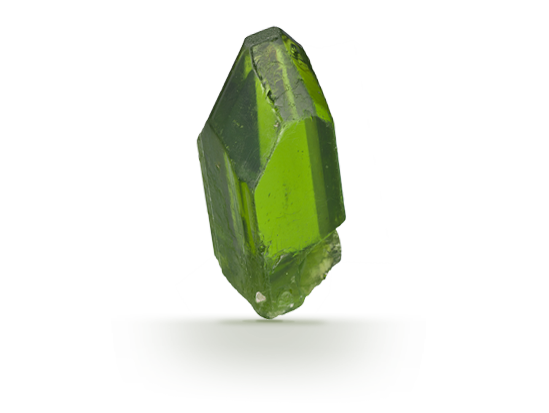OVERVIEW
The ancient Egyptians mined peridot on the Red Sea island of Zabargad, the source for many large fine peridots in the world’s museums. The Egyptians called it the “gem of the sun.” Today this gem is still prized for its restful yellowish green hues and long history. Large strongly-colored, examples can be spectacular, and attractive smaller gems are available for jewelry at all price points.
Gem miners find peridot as irregular nodules (rounded rocks with peridot crystals inside) in some lava flows in the United States, China, and Vietnam and, very rarely, as large crystals lining veins or pockets in certain types of solidified molten rock. Sources for the latter include Finland, Pakistan, Myanmar, and the island of Zabargad.
Geologists believe both types of deposits relate to the spreading of the sea floor that occurs when the earth’s crust splits, and rocks from its mantle are pushed up to the surface. Sometimes—as in Myanmar— these rocks can be altered, deformed, and incorporated into mountain ranges by later earth movements.
- Mineral: Olivine
- Chemistry: (MgFe)2SiO4
- Color: Yellowish green
- Refractive index: 1.65 to 1.69
- Birefringence: 0.035 to 0.038
- Specific gravity: 3.34
- Mohs Hardness: 6.5 to 7
WHERE IS IT FOUND ?
Peridot, the August birthstone, has an amazing story. Although most of the peridot seen in jewelry today comes from sources such as China, Myanmar, Pakistan, Tanzania, Vietnam and the United States, some journied to Earth on meteorites while others are found in exotic locales like Peridot Beach, Hawaii, where the sands shimmer a luminous green.
Arizona is the main source of this August birthstone in the United States. Massive volcanic eruptions many thousands of years ago sent rivers of lava spilling across the desert landscape of what is today the San Carlos Apache Indian Reservation, where some Apache families have worked the mines for decades.
CARE & CLEANING
With a hardness of 6.5 to 7 on the Mohs scale of harness, peridot is softer than many gems and cannot take hard wear, so it is not recommended for daily use in a ring. This August birthstone can also be damaged by some acids and even by long-term exposure to acidic perspiration. Cleaning peridot is a delicate process. Never use a steam or ultrasonic cleaner, as your peridot birthstone is vulnerable to thermal shock. It is safest to use a s0ft-bristle brush with a mild dish soap in warm water. Peridot should be stored with care to avoid scratching by gems with greater hardness.
BIRTHSTONE
Peridot is the birthstone for August and the 15th anniversary gemstone.
HISTORY
Peridot has always been associated with light. In fact, the Egyptians called it the “gem of the sun.” Some believed that it protected its owner from “terrors of the night,” especially when it was set in gold. Others strung the gems on donkey hair and tied them around their left arms to ward off evil spirits.
The word peridot comes from the Arabic “faridat,” which means “gem.” Most peridot formed deep inside the earth and was delivered to the surface by volcanoes. Some also came to earth in meteorites, but this extraterrestrial peridot is extremely rare, and not likely to be seen in a retail jewelry store.
Early records indicate that the ancient Egyptians mined a beautiful green gem on an island in the Red Sea called Topazios, now known as St. John’s Island or Zabargad. Legend has it that the island was infested with snakes, making mining unpleasant until an enterprising pharaoh drove them into the sea. From the earliest times, people confused this stone—now known to be peridot—with other gems. It was one of many labeled as “topaz.”
Some historians believe that Cleopatra’s famous emerald collection might actually have been peridot. People in medieval times continued to confuse peridot with emerald. For centuries, people believed the fabulous 200-ct. gems adorning the shrine of the Three Holy Kings in Germany’s Cologne Cathedral were emeralds. They are, in fact, peridots.
Source of Content : www.gia.edu


